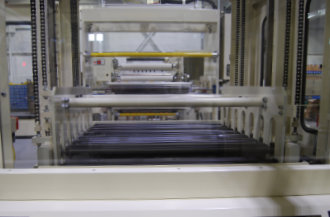

February 25 2021

As the name implies, a web accumulator is a machine built for one primary function, to accumulate and temporarily store material fed from or into a continuous process to a machine or operation that must be momentarily stopped or run slower than its processing line speed. The goal is to prevent any disruption of the continuous process while ensuring proper web tracking and tension for the concurrent processes during these speed changes. Accumulators are found immediately downstream of an unwind or upstream of a winder to facilitate roll changes at reduced speeds on web lines that cannot tolerate process speed changes while these roll handling functions are being performed.
Accumulators can take various forms, which are generally dictated by the level of web handling accuracy required, from simple J-box or flat belt scrays to precision-guided, translating multi-roller machines. A scray is used to gently fold the web in a serpentine manner. It most commonly uses a hook-shaped fabrication (aka a “J-box”) to passively let the web pile upon itself when the speed with which it is loaded into the scray is greater than the rate at which it is withdrawn from the opposite end. Many textile and non-woven processes have used this accumulator design for decades, as these webs can be much less sensitive to damage when handled in this manner and during potentially large tension variations. Conveyor-type scrays are often installed inside process ovens and facilitate long dwell times at the required conditions that allow a web to properly cure or dry without requiring an enormously long oven that occupies a lot of floor space in the factory.
Plastic extrusion lines, or roll-to-roll printing, laminating, or coating processes that demand more accurate web handling, will typically use roller-type accumulators, which more effectively control web handling behavior. These accumulators can store anywhere from a few inches to hundreds of feet of web material. They do this by passing the material over two groups of rollers that move apart from each other ― either one fixed and one translating group or two translating groups ― thus lengthening the web path as the roller groups move apart. They are more commonly designed with vertical roller movement; however, some horizontal designs exist that utilize the space above a pair of unwinds to achieve a more compact installation. Pneumatic or hydraulic cylinders can be used to actuate the moveable roller carriage(s) while maintaining the intended web tension, but motorized carriages are generally more precise. Alignment of the rollers both within each group and between groups can be critical for sensitive web applications. Design elements that ensure the translating roller carriage(s) remain level and aligned during movement are essential for proper web tracking but can quickly add complexity and cost to the machine.
It generally follows that manufacturing lines with processes that require long stoppage times will require more significant amounts of web storage capacity and thus more costly accumulators that can potentially occupy a larger area of your factory. To calculate the amount of storage required, you must first understand how much time a specific function (such as a splice on an unwind) will take and, therefore, how much material is being produced while the rest of the line runs at production speed. This time is typically the bulk of the storage requirement. However, any time the web speed entering and exiting the accumulator differs from the primary processing speed, such as during machine deceleration and acceleration, this differential speed results in additional storage capacity needed.
For example, let's say we are unwinding large rolls of material at a maximum speed of 200 feet per minute on a system that must stop the web to perform a butt splice. The stoppage-time required to complete the splice is 20 seconds. The unwind can slow the expiring roll to a stop in 5 seconds and then accelerate the new roll up to operating speed in 10 seconds. This accumulator's storage capacity is sized by calculating 8’-4" for deceleration, 66’-8" for splicing, 16’-8" for acceleration, for a total capacity of 91’-8". In practice, a factor of safety is applied to this calculation to account for deviations from the above estimates. An accumulator with 95 to 100 feet of storage capacity would therefore be recommended.
This capacity can be accomplished in several ways depending on the space available for the installation. It can be designed to be tall with fewer rollers in the machine direction. If overhead clearance is low, it must use more rollers and be longer in the machine direction to achieve the required capacity. Web width, minimum bend radius, and required web tension all determine the necessary roller sizes, impacting the overall machine footprint. An accumulator with five rollers in the translating carriage can store ten feet of the web for every foot of carriage movement. So, 100 feet of material storage would require ten feet of roller movement, which may require a machine that is over fifteen feet tall. If this exceeds the height constraint, more rollers are needed, thus allowing a decrease in height but with a corresponding increase in the machine's length and its cost. The cost can also vary substantially, not just based on the amount of accumulation necessary but also based on structural rigidity, carriage, and roller tolerances, and the possibility of requiring low friction and/or driven components to minimize drag.
Some processes can be automated and performed without slowing down, thus eliminating the need for a web accumulator. This automation can very often result in a more cost-effective solution that occupies less space on the factory floor. However, for those challenging applications where a process must slow down or stop, one proven method to fulfill your production requirements is using a web accumulator. In those situations, the vital decision is to choose the appropriate style that your material and process can tolerate.